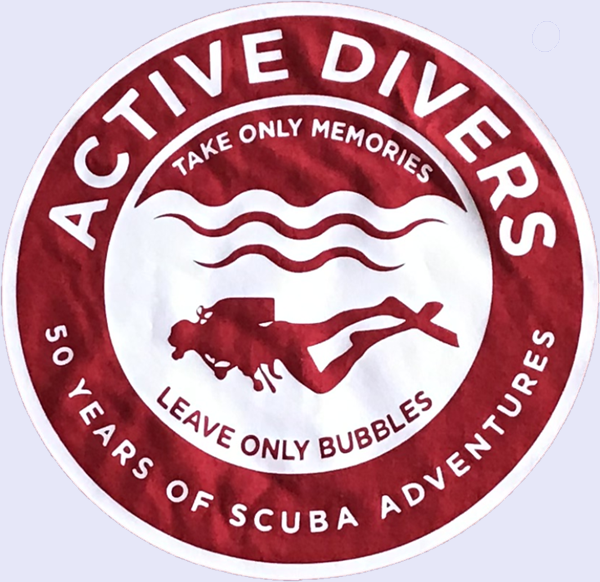![]()
- Bonaire Trip Report
- 2019 Annual Active Divers Dive Cruise
- Preserving Our Coral Reefs by Changing Your Brand of Sunscreen
- Maximum Sustainable Yield
- Dive Schedule Highlights
- Florida’s Coral Spawning Season Is About To Start
- Increases in Turtle Nesting Noted
- We Are Guests Here
- Test Your Knowledge
- No-Fault Dive Insurance
- Newsletter Delivery Options
- Email or Address Change?
- T-Shirts For Sale
- Active Divers Guidelines & Policies
“What an absolutely beautiful dive vacation! “
It seems only fitting to start this story with the quote above as it sums up what many of our international divers said about this trip... that this was the best Caribbean dive trip yet! Seventeen divers were booked on this trip but unfortunately, one person missed the trip due to transportation problems. Toucan Divers was the resort’s dive operator and they started out with an orientation and briefing on the marine park rules and the boat diving procedures the evening we arrived.
Bright and early the next morning we sat at our private group table in the concierge area of the restaurant getting some food prior to our 8:00 AM boat departure. Our group was the largest there and we had to split into two groups, one on the “Blue Moon” and the other on the “Green Flash”. Throughout the week we went on many of the same dive sites, but not all. While it would have been nice to be on one large boat, it was actually very pleasant to be in smaller groups on the reefs with less crowding.
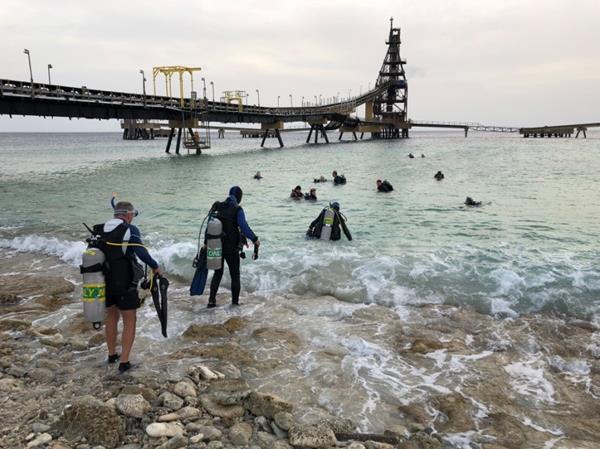 After
two morning dives, we had lunch and relaxed a bit before going for an
afternoon dive on the house reef, 18 Palms. It is absolutely amazing
how nice the reefs are in Bonaire just a few feet off shore, and the
house reef was no exception. Lots of tropical fish, healthy coral and
a squadron of tarpon greeted us that afternoon.
After
two morning dives, we had lunch and relaxed a bit before going for an
afternoon dive on the house reef, 18 Palms. It is absolutely amazing
how nice the reefs are in Bonaire just a few feet off shore, and the
house reef was no exception. Lots of tropical fish, healthy coral and
a squadron of tarpon greeted us that afternoon.
The rest of the week followed a similar pattern: eat, boat dives,
eat, shore dive, eat,  sleep and repeat! As we started our shore dives it
became apparent that every diver had to verify that they brought
everything they needed, plus some spare articles to share if needed.
One diver forgot to bring a BCD on the first shore dive, but that was
easily remedied by a quick trip back to the resort. For many, the
highlight of the shore dives was the Salt Pier, which we were able to
do as a drift dive in the morning and then as a dusk entry shore dive
that evening. It is an actual production pier with ships arriving
twice a week to fill with salt for export so you have to know the
schedule, since you cannot dive there when a ship is docked. Shown
above at right are divers preparing to start the dusk entry on the
pier.
sleep and repeat! As we started our shore dives it
became apparent that every diver had to verify that they brought
everything they needed, plus some spare articles to share if needed.
One diver forgot to bring a BCD on the first shore dive, but that was
easily remedied by a quick trip back to the resort. For many, the
highlight of the shore dives was the Salt Pier, which we were able to
do as a drift dive in the morning and then as a dusk entry shore dive
that evening. It is an actual production pier with ships arriving
twice a week to fill with salt for export so you have to know the
schedule, since you cannot dive there when a ship is docked. Shown
above at right are divers preparing to start the dusk entry on the
pier.
And then an hour later or so you see them starting to come out of the water.
Thousand of pictures were taken and many have been posted on Facebook, YouTube and in various emails of the trip both above and below water. The reefs were the star of the trip and in true Bonaire fashion they were all spectacular- simply no bad dives the entire trip!!

Bottom Row L to R: Jay Abbazia, Dennis Fiehler, Susan Noll, Daryl Johnson, Jason Fiehler, Cindy Sonntag, Zee Mayer, John Davis, Kathy Whitcomb
The Plaza Beach Resort and Toucan Divers went all out to make sure
we had excellent accommodations, great food, entertainment and
personal attention in the concierge area. Quincy was at our service in
the dining area and always asked “Do you need anything? Do you have
any problems? “. And he took care of everything we brought up!! In all
the trips I have planned and run, I got more accolades throughout this
trip than any other I have done. 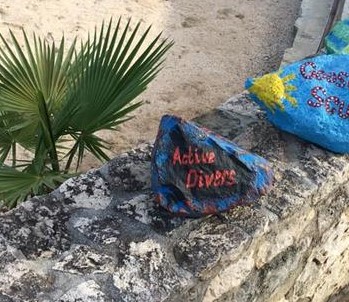
On the last night there, we were honored at a party at the dive shop with our own commemorative “rock” created by the shop that will remain for all to see that the Active Divers were there in 2019!
No trip report would be complete without a group picture so here it is on the right:
It’s going to be hard to top this trip but Dan and I will start shopping for the next great Caribbean adventure soon- any suggestions just send them to me at diverdaryl@bellsouth.net.
![]()
 Divers have
already booked shore excursion diving for Costa Maya and Roatan and
those do have a limited capacity. So if you are interested in going
you need to book now, and it is available on the “Sun Drenched Sale”
until August 15th. It is a spectacular itinerary on the Sky
Princess, the largest and newest ship in the Princess fleet! The
dive cruise is a round trip from Fort Lauderdale on December 7, 2019
for seven days and stops at four great dive locations: Grand Cayman,
Roatan, Costa Maya and Cozumel, and it is on sale now for as low as
$832! That’s only $119 per day per person for your lodging,
transportation, entertainment and all the food you can eat. Try and
match that price any other way you can to get to all these dive
destinations!!! And again, this is going to be a very popular cruise
since it is on a new ship, so I don’t expect a lot of sale prices as
we get closer to the departure date. The low price balcony cabins
are already sold out!
Divers have
already booked shore excursion diving for Costa Maya and Roatan and
those do have a limited capacity. So if you are interested in going
you need to book now, and it is available on the “Sun Drenched Sale”
until August 15th. It is a spectacular itinerary on the Sky
Princess, the largest and newest ship in the Princess fleet! The
dive cruise is a round trip from Fort Lauderdale on December 7, 2019
for seven days and stops at four great dive locations: Grand Cayman,
Roatan, Costa Maya and Cozumel, and it is on sale now for as low as
$832! That’s only $119 per day per person for your lodging,
transportation, entertainment and all the food you can eat. Try and
match that price any other way you can to get to all these dive
destinations!!! And again, this is going to be a very popular cruise
since it is on a new ship, so I don’t expect a lot of sale prices as
we get closer to the departure date. The low price balcony cabins
are already sold out!
So how easy is it to book the fifth annual dive cruise in 2019?? All you have to do is call our Cruise Planner, Karen Bradder at 1-800-901-1172 ext. 41643 and tell her that you want to book the Active Divers cruise and make a deposit. That’s it, no muss, no fuss and you will be ready for an outstanding trip with ADA!!
See you onboard!
![]()
Your Brand of Sunscreen—A Simple Solution
--by Roy D. Wasson
Conservation Projects Director
As those of us Active Divers Association members who participate in our regular Coral Restoration Foundation programs already know, there is one contributing factor accelerating the demise of the world’s coral reefs that can easily be handled. Many harmful chemicals commonly found in sunscreen contribute to the problem. By the numbers, the problem is daunting: 14,000 tons of sunscreen are thought to wash into the oceans each year; 82,000 chemicals from personal-care products are tainting the seas; about 80 percent of corals in the Caribbean have been lost in the last 50 years due to pollution, coastal development, and warming waters. Even if you cannot participate in a coral planting project with us, you can do your part by reading the ingredients on your sunscreen and stopping use of the harmful ones.
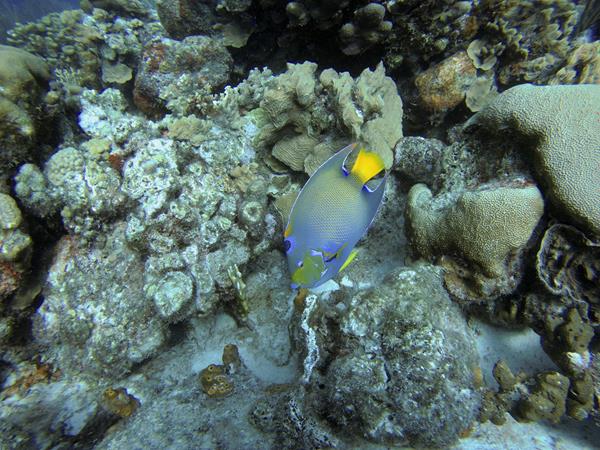 When
you swim or dive with sunscreen on, chemicals like oxybenzone and
octinoxate seep into the water, where they’re absorbed by corals.
These substances contain nanoparticles that can disrupt coral’s
reproduction and growth cycles, ultimately leading to bleaching.
Instead, choose mineral-based sunblocks that use zinc oxide or
titanium dioxide, which use non nano-size particles that can’t be
ingested by corals. Haereticus Environmental Lab publishes a list each
year of what sunscreens are safe for the environment, and the
Environmental Working Group rates products with SPF values—including
some 650 sunscreens and 250 moisturizers—on their environmental
impact.
When
you swim or dive with sunscreen on, chemicals like oxybenzone and
octinoxate seep into the water, where they’re absorbed by corals.
These substances contain nanoparticles that can disrupt coral’s
reproduction and growth cycles, ultimately leading to bleaching.
Instead, choose mineral-based sunblocks that use zinc oxide or
titanium dioxide, which use non nano-size particles that can’t be
ingested by corals. Haereticus Environmental Lab publishes a list each
year of what sunscreens are safe for the environment, and the
Environmental Working Group rates products with SPF values—including
some 650 sunscreens and 250 moisturizers—on their environmental
impact.
Even if you are only sunbathing and have no intent to jump into the water, these harmful sunscreens are killing the coral. When dozens (or hundreds or thousands) of beachgoers spray on their sunscreen using aerosol spray cans, enough of the spray that misses the target accumulates on the surrounding sand and eventually washes into the surf, killing corals. Also, even if you skip the aerosol and rub on the lotion, the chemicals go down the drain when you shower and work their way into the ecosystem.
Several local, state, federal and international governmental efforts are underway to ban such harmful sunscreens. The City of Key West voted earlier this year to ban the sale of sunscreen containing chemicals that harm coral reefs. The measure, which the City Commission approved in a 6-to-1 vote, will ban sales of sunscreens containing oxybenzone and octinoxate. The legislation will go into effect on Jan. 1, 2021. Last year lawmakers in Hawaii passed a bill banning the sale of sunscreens containing oxybenzone and octinoxate. Hawaii is the first state to pass such a measure, and it also goes into effect as a law on January 1, 2021l.
The Western Pacific nation of Palau has become the first country to ban many kinds of sunscreen, in a move to protect its coral reefs from chemicals that scientists say cause significant damage. Under the ban, which will take effect in 2020, “reef toxic” sunscreen—defined as containing one of ten prohibited chemicals, a list that could grow later—can be confiscated from tourists when they enter the country, and retailers who sell it can be fined up to $1,000. Palau’s President Tommy Remengesau called the ban “especially timely,” saying that a major impetus was a 2017 report that found sunscreen products to be “widespread” in Jellyfish Lake, one of the country’s Unesco World Heritage sites.
Although the current political climate in Washington has been less than ideal for environmental issues, some members of Congress are working to make the ban on harmful sunscreen chemicals a nationwide one. Francis Rooney, a Republican, introduced a bill earlier this year banning the “human use of oxybenzone and octinoxate near coral reefs in National Marine Sanctuary System including the Great Florida Reef found off the coast of the Florida Keys.” He was joined by Rep. Debbie Mucarsel-Powell, a Democrat, as a cosponsor. Since then, the bill has gained three more cosponsors including U.S. Rep. Alcee Hastings. Rooney explained the rationale behind the proposal:
“These chemicals are killing our coral reefs, which are vital to the marine ecosystem here in Florida and around the world,” Rooney explained. “Reefs play a major role in preventing shore erosion and protect coastal wetlands. Their preservation is a key component of our tourism-based economy. I introduced the Defending Our National Marine Sanctuaries from Damaging Chemicals Act to protect these critical areas so that they can be enjoyed and studied for generations to come. It is common sense to prevent the application of these chemicals in National Marine Sanctuaries.” The pending legislative effort follows Rep. Rooney’s earlier proposal to have the U.S. Commerce Department “issue regulations prohibiting the use of sunscreen containing oxybenzone or octinoxate in a National Marine Sanctuary in which coral is present, and for other purposes.”
Do your research before buying a bottle of sunscreen, to find a coral-friendly brand. Or skip the sunscreen altogether. Wearing hats, shirts, and other apparel incorporating UV protection, and staying in the shade will greatly reduce the amount of sunscreen you need. You may not have the time to dive with Active Divers on a coral restoration project, but you can still do your part to help preserve our precious reef system from further degradation as we work to re-grow new corals.
![]()

Tiger Shark
It sounds like we can figure this out easily enough, but first let's define it. It is a population of some creature (we’ll take fish in this example) that can be removed with the remaining population increasing back to the same size. Therefore, there is a harvest that is there for the taking without any harm to the species. Sounds great, but is it real, isthat how the real world exists?
Some go even further and state it is good to weed out some of the population so the strong will survive and will be better suited for growth. This is very appealing to the people doing the fishing but have you come up with any problems with this magical theory?
Well, for one thing we don’t know the past history of the populations and how they have fared over different timeframes or what caused these differences. What about a natural fluctuation within this species? Is there one or not? What about changes in their environment? Does that matter? How about diseases within the species? Do they have them (i.e.: black plague)? How about a season of heavy hurricanes? Does that affect them?
What about their food supply? And while we are at it, they don’t live in isolation, so does what happen to other species that depend on them for THEIR food supply?
I think you have now noted we cannot take a species out of the whole and make an educated guess on the maximum sustainable yield until we have all this information. But that is exactly what some organizations, the International Whaling Commission for example, have done. Personally, I don’t think that is workable. Time to bury this idea with history and start a new one.
![]()
Dive season is in full swing, and there are some awesome upcoming dives featuring interesting experiences on the Active Divers schedule for 2019. Check out these upcoming dives:
Looe Key And Key West - August 3-4
This is our annual excuse to get down to the lower Keys each year. The Looe Key National Marine sanctuary boasts incredible finger reefs, and the famous Looe Key Resort And Tiki Bar is a Florida Keys tradition offering modest accommodations at reasonable rates with easy access to all of Key West’s famous attractions. For Active Divers, this includes the Vandenburg, one of our best deep wrecks in the Florida Keys. This large wreck complete with swim-through satellite dishes is sure to be a highlight of your trip to Key West.
Islamorada Night Dive - August 17
If you’ve never experienced a night dive before, this is your chance. Many times critters we rarely see during the daylight hours come alive at night. Lobsters walking around in plain view, sleeping parrotfish, crabs, sea stars, large open basket stars and octopus are frequently observed on a night dive. Even if you’ve never tried night diving, our Safety Officers will guide you through.
Goliath Grouper Dive - September 14
Last year I spoke to the legendary Jim Abernathy about the best time to see the annual Goliath Grouper aggregation that occurs in the waters off West Palm Beach. He said the aggregation peaks in the days around the full moon in September. This year the full moon is the day of our dive and we will witness their amazing aggregation. See for yourself in our video from last September’s dive: https://youtu.be/NUt6d8pn224
Spiegel Grove - September 22
This is one of the premier wrecks in South Florida. It’s so large it takes many dives to see it all. Eight down lines reach all parts of this massive wreck. Also check out the Duane (August 11) and the Eagle (October 6) if you like big wrecks.
Blue Heron Bridge - November 16
Lastly, we cap off the dive season with our end of season picnic at the bridge, offering unusual sightings such as a resident batfish, octopus and a plethora of large yellow cushion sea stars. See our video from the first kickoff picnic at the bridge on April 6 this year: https://youtu.be/kpeDAbWD16E
Whatever kind of diving your into, our dive schedule offers something for everyone. See you on the boat!!!
![]()
This week I have the privilege of diving into one of greatest unknown places on our planet. That is our beautiful ocean. Here is Bonaire, the water is clear and clean, the reefs are healthy, and life is plentiful. Something about this beautiful place reminds me of how much we are all connected.
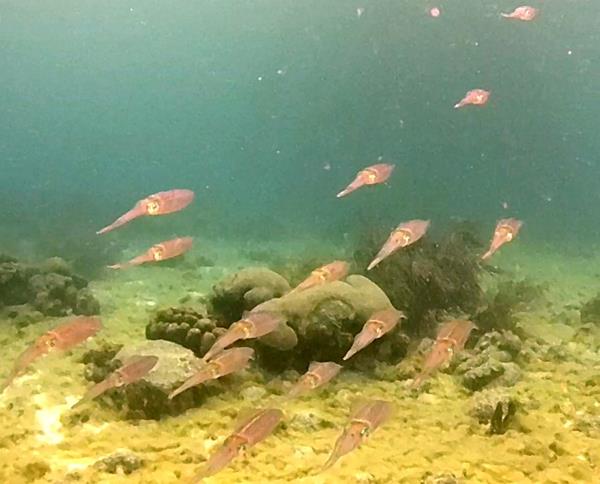 School
of squid - Salt Pier, Bonaire
School
of squid - Salt Pier, Bonaire What I do to the ocean I also do to myself. I am sustained by all live. If I think about the concept of the hierarchy of the food chain I realize that the ocean is ultimately what sustains all life on the planet. There is a misconception that, because the ocean is so vast that it cannot be negatively impacted. We have seen that to be wrong. Even the smallest action has a ripple effect upon the entire ecosystem.
As a member of Active Divers I am proud to be part of an organization that cares about the ocean. I am proud that we do see ourselves as guests in this incredible place.
What would life on this planet be like if we were believe that all life here was important? I believe that Active Divers is about much more than having fun in the ocean. It is about respecting this incredible place. And, it teaches us to be respectful of each other. We are all guests in the ocean, and we are all guests in each other's lives. If we treated each other with that same level of respect, the world in general would be a better place.
![]()
-- by Sam Helmy -July 19, 2019
Reproduced from Deeper Blue
 It’s that time of
year again, so it’s worth packing your dive gear and heading down to
the Florida Keys for the annual Coral spawning season. Typically the
coral spawn takes place several days after the late summer full moon.
The coral spawn can take up to three nights, with the corals on the
reef synchronizing the release of sperm and eggs into the water. The
spawning can be observed by snorkellers and divers alike, and several
dive operators in the Florida Keys run special trips to observe the
spawning when it is happening. Interestingly not all the different
species of coral spawn at the same time. And each species will spawn
individually at a time night when the conditions are optimal. Once the
corals have spawned, the eggs and sperm will float around in the sea
for up to two months before settling on the sea floor to start forming
a new coral polyp. The event is studied by scientist every year to
gain a better understanding of coral reefs, and how there reproductive
cycles. You can find out more about dive operators in Florida here, or check out a video about some of the
scientific work done during the spawn below.
It’s that time of
year again, so it’s worth packing your dive gear and heading down to
the Florida Keys for the annual Coral spawning season. Typically the
coral spawn takes place several days after the late summer full moon.
The coral spawn can take up to three nights, with the corals on the
reef synchronizing the release of sperm and eggs into the water. The
spawning can be observed by snorkellers and divers alike, and several
dive operators in the Florida Keys run special trips to observe the
spawning when it is happening. Interestingly not all the different
species of coral spawn at the same time. And each species will spawn
individually at a time night when the conditions are optimal. Once the
corals have spawned, the eggs and sperm will float around in the sea
for up to two months before settling on the sea floor to start forming
a new coral polyp. The event is studied by scientist every year to
gain a better understanding of coral reefs, and how there reproductive
cycles. You can find out more about dive operators in Florida here, or check out a video about some of the
scientific work done during the spawn below.
Increases in Turtle Nesting Noted
The Florida National Estuaries Research Reserves report that during the 2019 nesting season there have been amazing increases in the counted nesting sites throughout Florida. At St George and Little St George islands there were 139 loggerhead, 2 green, and one leatherback nests, a 130% increase over last year. Ponte Verde had 99 vs 30 a year ago, a 230% increase. Naples beaches had 512 vs 306 last year. The reason for the yearly differences is unknown.
If you see a sick, injured, or stranded turtle, call the Florida Fish and Wildlife Conservation Commission at 888-404-3922
![]()
Want your newsletter delivered via snail-mail? Contact the webmaster and request a printed copy. Be sure to put "Active Divers Newsletter" in the subject.
![]()
If so, please email or call us with your current information. You may send an email to: Dr. Dan Baeza, Membership Chair at ActiveDiversInfo@gmail.com. You can also call Dan at 954-260-8225 and leave a message with your new contact information.
Active Divers T-Shirts For Sale
We've revamped our logo! Show your pride in the best dive club anywhere and pick up a tee with a brand new logo. Hover over the t-shirt to see the logo in detail. Sizes small, medium, large, xlarge, xxlarge. Some tank tops available also. All shirts are $10 each. CALL LON AT 305-251-4975 AND PLACE YOUR ORDER TODAY!. Lon will deliver it to you on your next dive
Return to Index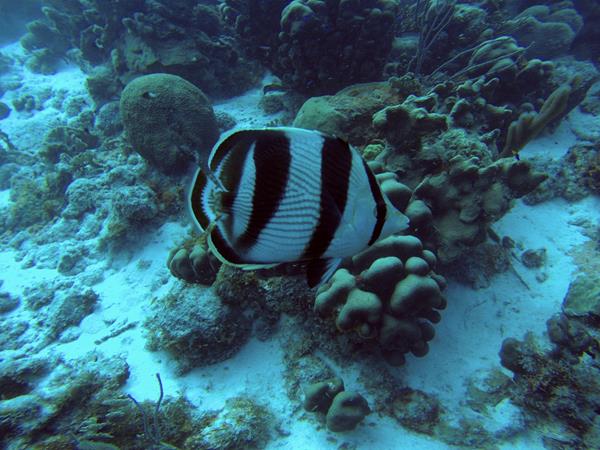
What is the weight of a cubic foot of sea water?
a. 64.0 pounds
b. 62.4 pounds
c. 42.6 pounds
![]()
Did you know that Active Divers offers dive insurance? You may have noticed the "Dive + Insurance" option when purchasing a dive on our schedule page. For a $5 fee at the time of booking your local dive, you may insure your dive fee against any unforeseen problem that could preclude you from making the dive.
If for any reason you are unable to attend a local dive for which you are scheduled and have paid the insurance, Active Divers will credit your dive fee to another date. The $5.00 insurance is non-transferable and non-refundable.
For more information, see the "Active Divers Trip Cancellation Insurance" description at https://activedivers.org/Guidelines.html.If you have additional questions, please send us an email message at ActiveDiversInfo@gmail.com.

